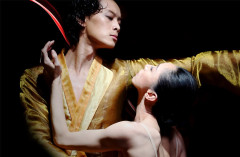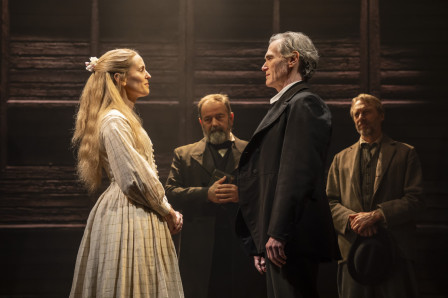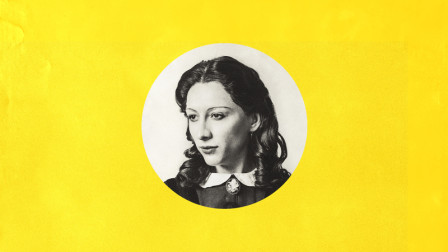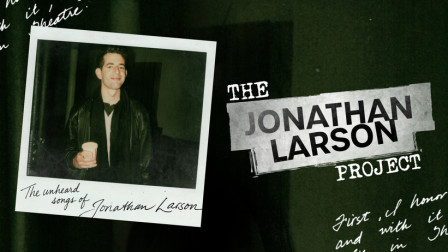Review: SHANGHAI BALLET, ECHOES OF ETERNITY at ENO's Coliseum
 Russian dancers fleeing the revolution first introduced the western art form of ballet to the city of Shanghai in the 1920s, with Madame Mao personally promoting the formation of China's national dance school in the 1950s. Xin Lili, herself one of the company's former leading dancers has been director for the past 15 years and advocates interpretation and inclusion of both western-inspired classics and more traditional, Chinese-stylised subjects.
Russian dancers fleeing the revolution first introduced the western art form of ballet to the city of Shanghai in the 1920s, with Madame Mao personally promoting the formation of China's national dance school in the 1950s. Xin Lili, herself one of the company's former leading dancers has been director for the past 15 years and advocates interpretation and inclusion of both western-inspired classics and more traditional, Chinese-stylised subjects.
In this, their first London season since choreographer Patrick de Bana's "Jane Eyre" in 2013, Coliseum audiences are afforded an opportunity to experience Shanghai Ballet's new offering "Echoes of Eternity", which has been directly interpreted from the famous 8th century tragi-poem "The Song of Everlasting Regret". It tells of the romance, conflict and ultimate tragedy which befalls the Emperor Xuanzong and his concubine Yang Guifei who sacrifices herself to save the man she loves.
The story, which was used as the basis for the play "The Palace of Eternal Life", has parallels in many cultures - notably Hindu - where the universal human preoccupations with passion, jealousy, pride and self-sacrifice appear in many guises; indeed, musical theatre aficionados may readily identify the themes tackled here, reworked in the telling of Tuptim's story in "The King and I".
This co-production by the Shanghai Ballet and Shanghai Grand Theatre is awash with beautiful imagery beginning with the austere, measured and sophisticated elegance of a dancer symbolizing a melancholy white egret backing onto the stage. In Chinese culture such a bird depicts strength, patience and is the acknowledged guider of departed souls to heaven, which gives an essence of the tragedy to come.
The Principals consistently deliver crisply executed and languorous yet vibrant interpretations of de Bana's choreography - most notably Zhang Yao and Zhang Wenjun, whose interpretive dance skills are most emphatically spot-lighted when juxtaposed against the backdrop of the male (and more noticeably) female corps. Despite their efforts however, the positioning of the ensemble is an unfortunate one. At the performance I attended, the female dancers in particular, were seemingly resolute in their denial of the rudimentary principles of synchronicity, with arm extensions and head positioning frequently assuming a state of breathtaking chaos. Whilst it is understandable that de Bana should focus on the Principals, as his international standing rises further, it is to be hoped that his desire for perfection will embrace the whole company - alternatively he will be sorely in need of an effective assistant with both the patience and capacity to help the less experienced, whilst reining-in the more undisciplined elements of the ensemble.
Even an uninitiated observer would concede that the full company montages suffer as a result of these inadequacies, but strong compensation is delivered by the creative team in the form of Agnès Letestu's fiery jewel box of silk costumes which provide a feast for the eyes which is further enhanced by James Angot's subtle lighting states.
One word of warning to the uninitiated: it is considered acceptable among Chinese audiences to whisper comments during a live performance, a practise which may seem incongruous and inappropriate to a western dance audience who reserve their emotional outpourings to key moments and the curtain calls. If you can embrace the distraction of such minor differences, the rewards to be found in this moving blend of orient and occident are worth the ticket price.
"Echoes of Eternity", a new work for Shanghai ballet by German-Nigerian choreographer Patrick de Bana, runs at ENO's Coliseum from 17th to the 21st August.
Latest News

 Production images released for HIGH NOON
24 December 2025 at 10:54
Production images released for HIGH NOON
24 December 2025 at 10:54

 Full Cast Announced for SHADOWLANDS in the West End
22 December 2025 at 13:14
Full Cast Announced for SHADOWLANDS in the West End
22 December 2025 at 13:14

 Review Round-Up: OH, MARY! at the Trafalgar Theatre
19 December 2025 at 15:53
Review Round-Up: OH, MARY! at the Trafalgar Theatre
19 December 2025 at 15:53

 The Jonathan Larson Project announces London premiere
19 December 2025 at 10:31
The Jonathan Larson Project announces London premiere
19 December 2025 at 10:31
